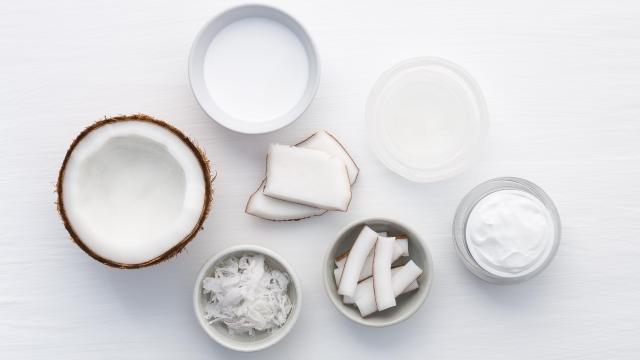When it comes to following a recipe, the first step is making sure you’ve got the right ingredients. This can be especially tricky if an ingredient has a name that is similar to a different product. I don’t mean walnut pieces and walnut halves (there’s not much at risk with that mix up), but pondering the labels of canned coconut cream and cream of coconut might have you confused about what exactly is going on in this fruit anyway. Here’s some clarity on what some of the most confusing coconut liquids are, and how you can use them.
Coconut milk
At its most elemental, coconut milk is made from shredding the meat of mature coconuts, processing it with hot water, and pressing it to extract the rich liquid. This liquid is opaque and white with a creamy texture, and an abundant coconut flavour and aroma. The viscosity is due to the drupe’s flavorful saturated fats, while the water content ensures it is still runny at room temperature. Coconut milks have gotten a little blurred in the boom of non-dairy milks, however.
In the past, depending on the company, coconut milks would include two or three ingredients: coconut, water, and maybe guar gum (a stabilizer). Now, you’ll find cartons of coconut milk with added vitamins, minerals and thickeners trying to compete with dairy milk for your coffee and cereal. While having options for different diets is wonderful, don’t shop for your coconut milk in the milk fridge if you intend to cook with it.
Coconut milk is used in both sweet and savoury recipes, like Thai green curry, Filipino bibingka, coconut pudding, piña coladas, and as a vegan milk replacement. My family’s go-to brand has always been Chaokoh, but many stores will have a variety of brands to choose from. I suggest getting the coconut milk in cans in the dry goods aisle, so you’re not cooking with those added ingredients and sugars the carton milks may have. Check the ingredient list for coconut, water, and guar gum (some organic brands won’t even use a stabilizer).
Lite coconut milk will be right next to the regular coconut milk. (I’m including it in this section because the name isn’t as confusing.) This variety has less fat. When making lite coconut milk the coconut meat is processed with more water, so it’s literally watered down. While this can be a low-fat option for your recipes, water has no flavour. You can expect the final product to be less creamy and, sadly, less coconutty.
Coconut cream
Coconut cream is closely related to our coconut milks above, but Big Coconut decided to give it a new fancy name. While lite coconut milk has a lower concentration of coconut fat, and regular coconut milk has a higher level of coconut fat, coconut cream has the highest amount of coconut fat commonly available to us in the grocery store. (Read here for the composition breakdown of commercial coconut milks.) It’s made the same way as coconut milk, and contains the same ingredients, but with different ratios. When you open a can of coconut cream after it’s been chilled and before it’s been shaken, the cream will solidify and you’ll be able to separate the solids from the water. Do this with coconut milk and lite coconut milk, and you’ll see proportionally smaller rafts of solidified fat.
Coconut cream is rich and luxurious, so you may see it pop up in chilled, sweet recipes, like ice cream, mousses, puddings, tarts, and as a dairy-free whipped cream option. Coconut cream can also be a good non-dairy cream replacement in savoury dishes like alfredo or creamy soups. I don’t see it as often in cakes and hot, savoury dishes, as the high percentage of fat can throw off other ratios in the recipe. Instead, you might see regular coconut milk listed, or a combination of both regular coconut milk and coconut cream.
Cream of coconut
Cream of coconut is the easiest to confuse with coconut cream, and with the most disastrous consequences. I can almost guarantee your non-dairy chicken alfredo recipe does not suggest you cook with this stuff. Cream of coconut is a cloying coconut syrup used primarily in cocktails or desserts. Commercial cream of coconut is made by adding copious amounts of sugar to coconut milk along with a team of stabilizers, emulsifiers, and sometimes synthetic thickeners. What you get is a viscous, translucent white syrup that will both sweeten recipes and add coconut flavour in one go. You can make your own cream of coconut at home if you’re not interested in the additives that come in the bottles.
Coconut water
Back to basics. Coconut water had its time in the sun but it can still be confusing, especially in the grocery store aisle. Coconut water is simply the water found in the centre of a coconut. Commercially, and whenever you see a coconut with a straw sticking out of it, it’s harvested from young coconuts. The liquid is thin, slightly sweet, and has a subtle coconut flavour. You may also see it labelled as coconut juice, and it can come in bottles, cans, cartons, or coconuts.
Coconut water is very common as a drink, but since it’s subtle in flavour and watery in consistency, you can absolutely cook with it to add a hint of flavour to your meal. Think of it as water with an attitude. Try making a soup with coconut water in the broth, braise meats with it, or try some popsicles. Have some fun and explore all the flavorful liquids this fabulous fruit has to offer (with a little less confusion).

Leave a Reply
You must be logged in to post a comment.